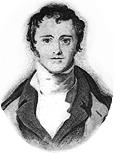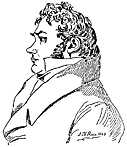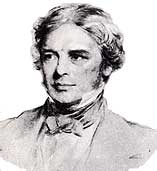![]()
![]()
Alesandro Volta (1745-1827), after reading about frog muscles twitching due to an unknown source of electricity, guessed that the electricity might be created by a reaction of metal hooks with a second metal support. In 1800 he verified his hunch using a battery of many sandwiches stacked into a tall pile, each sandwich being two disks of different metals separated by a wet pasteboard spacer. This for the first time made it possible to produce a steady current flow of electricity rather than rely on erratic, short-lived, occasional sparks. Volta's electrical battery revolutionized the study of electricity, provided a powerful new tool for chemistry, and started radical cultural changes. (Read Volta's account at Chem Team.)
 When he heard of Volta's new electrical pile, Humphry Davy (1778-1829 ←at left) in England constructed his own electrical pile, and almost immediately observed bubbles produced in a drop of water placed on the top of the pile to improve the electrical connection. While previously it had been discovered that water is composed of Hydrogen and Oxygen, Davy realized that the electrical separation of water suggested the potential for separating
When he heard of Volta's new electrical pile, Humphry Davy (1778-1829 ←at left) in England constructed his own electrical pile, and almost immediately observed bubbles produced in a drop of water placed on the top of the pile to improve the electrical connection. While previously it had been discovered that water is composed of Hydrogen and Oxygen, Davy realized that the electrical separation of water suggested the potential for separating earths
which had previously resisted separation and analysis. Lavoisier had earlier proposed that earths might be simply metallic oxides (compounds of oxygen and metal) inseparable by available methods.
In 1807 Davy's attempted to separate melted potash, discovering a flammable metal which he named Potassium. A few days later Davy isolated a similar new metal which he called Sodium. In May 1808 Jöns Jakob Berzelius (1779-1849 at right→) wrote from Sweden to Davy that he and Dr. Pontin, the king's physician, had decomposed both lime and baryta. By July Davy had used the method to separate and discover Strontium, Barium, and Magnesium.
 Berzelius suggested that all atoms have different amounts of positive and negative electric charge. He arranged the atoms in a series from potassium, the most positive, to oxygen, the most negative. Atoms stick together electrically to form compounds. I.e., Berzelius was convinced that chemical bonds are merely electrical attractions. Berzelius suggested that many compounds may have residual charge allowing them to form more complex salts and hydrates. In 1813 he proposed chemical symbols using the initials of their Latin names that was slowly adopted and continues in use today. In 1822 he began publishing Jahres-Bericht, an annual review which reported his researches and those of others he considered most significant. His manual on blowpipe analysis was the standard for years. Berzelius made several long trips about Europe, becoming acquainted with the important scientists. His wide correspondence kept the international community of chemists informed about scientific progress everywhere.
Berzelius suggested that all atoms have different amounts of positive and negative electric charge. He arranged the atoms in a series from potassium, the most positive, to oxygen, the most negative. Atoms stick together electrically to form compounds. I.e., Berzelius was convinced that chemical bonds are merely electrical attractions. Berzelius suggested that many compounds may have residual charge allowing them to form more complex salts and hydrates. In 1813 he proposed chemical symbols using the initials of their Latin names that was slowly adopted and continues in use today. In 1822 he began publishing Jahres-Bericht, an annual review which reported his researches and those of others he considered most significant. His manual on blowpipe analysis was the standard for years. Berzelius made several long trips about Europe, becoming acquainted with the important scientists. His wide correspondence kept the international community of chemists informed about scientific progress everywhere.
 Davy claimed that his greatest discovery was Michael Faraday (1791-1867 ←at left), a poorly educated bookbinder's apprentice. As a guest of a shop patron, Faraday attended several of Davy's lectures at the Royal Institution, London, recorded extensive lecture notes and apparatus illustrations, then bound and sent them to Davy with a plea for employment. Davy hired Faraday in March 1813 then retired from the Institution upon his marriage. That autumn Davy and his wife toured France and Italy, meeting with the continent's noted scientists, and taking Faraday along as secretary and assistant. Faraday returned to the Royal Institution, eventually rising to be director in 1825. Following Oersted's 1820 discovery that electric current creates a magnetic field, Faraday began investigating that connection and the possibility of creating electric current with a magnetic field (which he discovered in 1831). Beginning in 1823 Faraday also began liquefying numerous gases with cooling and pressure. Studying the electrolysis of a copper sulfate solution, Faraday found the amount deposited depends only on the amount of electric current and the elapsed time.
Davy claimed that his greatest discovery was Michael Faraday (1791-1867 ←at left), a poorly educated bookbinder's apprentice. As a guest of a shop patron, Faraday attended several of Davy's lectures at the Royal Institution, London, recorded extensive lecture notes and apparatus illustrations, then bound and sent them to Davy with a plea for employment. Davy hired Faraday in March 1813 then retired from the Institution upon his marriage. That autumn Davy and his wife toured France and Italy, meeting with the continent's noted scientists, and taking Faraday along as secretary and assistant. Faraday returned to the Royal Institution, eventually rising to be director in 1825. Following Oersted's 1820 discovery that electric current creates a magnetic field, Faraday began investigating that connection and the possibility of creating electric current with a magnetic field (which he discovered in 1831). Beginning in 1823 Faraday also began liquefying numerous gases with cooling and pressure. Studying the electrolysis of a copper sulfate solution, Faraday found the amount deposited depends only on the amount of electric current and the elapsed time.
Although the concepts of atoms and molecules were very useful for chemistry, because there was no direct evidence of their reality, those concepts remained controversial. Therefore many scientists including Davy and Faraday tried to avoid using those terms. Comparing combining ratios obtained by measuring the masses and volumes of gases in chemical reactions previously allowed chemists to guess molecular formulas. But many chemists had developed conflicting lists of formulas and resulting relative weights of atoms. Faraday realized that if the same electrical current runs though a series of electrolysis reactions, the amounts of substances deposited would necessarily be electrically equivalent. Faraday would have been able to produce a more reliable list of the relative atomic weights for each kind of chemical element, but he shied away from using that term. Berzelius refused to accept Faraday's conclusions so also avoided using electrolysis data to calculate atomic weights. Chemists studying organic substances (produced by living creatures) found electrical attraction inadequate for explaining organic molecules and so also rejected Faraday's electrolysis findings.
experiment to follow
Finally, record your procedures, measurements, and findings in your journal. If you need course credit, use your observations recorded in your journal to construct a formal report
![]()
next Experiment
to ie-Physics menu
to site menu